As increasingly empowered passengers seek new ways to take control of their own travel experience, the industry has embraced ever more ingenious technologies and intelligent innovations in answer to demands for an extraordinary airport journey. Be it to ease navigation, reduce waiting times in queues, provide flight information or help airports to plan, Information Technology and inventive solutions are shaping air travel as we know it.
A touch of smart thinking
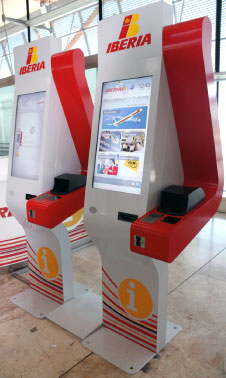
As part of Iberia’s Project Ágora more than 200 airport initiatives were assessed, to identify the ways in which Iberia could lead in on-time performance; streamline, simplify and improve the customer experience; continually improve airport efficiency; support and develop its employees; and leverage the ‘Iberia spirit’ to make Madrid a global reference hub.
Iberia’s Project Ágora has transformed Madrid Barajas Airport’s Terminal 4 into a world-class airline hub. Its all-encompassing, customer-centric approach makes use of revolutionary IT innovations to deliver a world-class service, for a new paradigm of customer with more demands and higher expectations than ever.
As part of the project, more than 200 airport initiatives were assessed to identify the ways in which Iberia could lead in on-time performance; streamline, simplify and improve the customer experience; continually improve airport efficiency; support and develop its employees; and leverage the ‘Iberia spirit’ to make Madrid a global reference hub. All of Project Ágora’s implementations are driven by their impact on the passenger’s ability to customise his airport journey, focusing not only on one single touch point but being consistent across the whole value chain, to contribute to a stress free customer experience and to increase their satisfaction.
“IT innovations, mobile solutions, proactive assistance and redefinition of processes – with a touch of smart thinking and always with the support of IT solutions – will drive the change in core airport processes,” said Alex Rivera Gil, Airport Development Project Manager. “Passengers want many different things – and that is actually driving the change – but they all have one thing in common: they want to feel independent and assisted at the same time.”
Spain’s largest airline has implemented countless IT innovations to put the passenger in control, and deliver a quick and simple airport experience while creating a ‘fit’ among Iberia’s self-service and mobile solutions so that they interact and reinforce one another through the entire passenger process. A next-generation visual queue management facility projects a six metre ‘floating’ image displaying the status of each check-in desk – showing green if a desk is free, red if it is occupied and grey if it is closed – and reducing queue times by six seconds for every passenger; a saving of 10 minutes for every 100. Iberia was also the first network carrier in the world to deploy virtual assistants – an advanced audiovisual system that aesthetically resembles a human agent – to provide information and capture the attention of passengers, encouraging them to use self-check-in kiosks. “Another unexpected advantage of this initiative is that the customer leaves the area with a smile, and that is priceless,” Rivera Gil added. In addition, ‘Quick Service Point’ touchscreen kiosks allow passengers to autonomously navigate, obtain information on airport facilities and flights, print a new boarding pass for connecting flights, print coupons and file complaints over delayed luggage. Meanwhile, with all airport information automatically updated across an integrated IT platform, roving customer service agents can assist with the processing of passengers using iPads to help speed up throughput.
An extraordinary IT experience
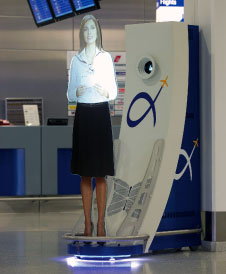
Leonidas Daravelis, Director, Information Technology & Telecommunications Business Unit of Athens International Airport: “In our days people are more familiar with technology enhancements. This in turn makes self-service a real service of preference for many of them, providing the ability to perform their airport-related transactions and fulfil their needs at their own pace and peace of mind, with minimum assistance. This is only possible through extensive use of the available IT technology.”
Industry-leading innovation is also taking place at Athens International Airport, where delivering an extraordinary passenger experience is at the forefront of development.
One of the latest additions to Athens International Airport’s diverse range of state-of-the art facilities is the Virtual Assistant Holographic Announcer, which provides travel information through projected videos, using the illusion of a human agent’s hologram, and next-generation solutions are being deployed airport-wide. In 2012 a Queue Management system performing automated, real-time measurements of the screening point queues through cameras and video analytics was installed, and similarly the airport’s ‘Time to Gate’ service has been recently introduced, to provide information to passengers regarding average queuing times at security screening points, as well as and the estimated walking time to boarding gates.
IT solutions are also enabling passengers to use their own devices and independently seek information within the airport. A 60-minute free wireless internet connection is offered through the ‘WizFree’ service, and a number of information and interactive information spots are available for public use, including All-in-One Kiosks – for telephone calls, flight information, free communication with the airport’s call centre, and automated destination weather forecasts, delivered simply by scanning a boarding pass.
Leonidas Daravelis, Director, Information Technology & Telecommunications Business Unit of Athens International Airport, said: “Brand new information points are planned to be deployed at both arrival and departure levels, supporting passenger interaction. These will provide real-time flight information, present food and beverage offers, allow real-time communication with the airport’s call centre, and finally greatly improve way finding using an airport map – as well as offering much more passenger-friendly information. All information points will be equipped with state-of-the-art IT equipment like multi-touch monitors, thin kiosks printers, QR and 2D barcode scanners, to name a few.”
The project is currently under implementation, with phased completion steps taking place throughout the year. Also within 2013 the airport’s Wayfinding Service will be introduced. This new development provides dynamic information regarding the user’s current location as well as directional guidance within the airport. The service will be implemented through new Infokiosks and the updated AIA Mobile App.
“In our days people are more and more familiar with technology enhancements,” Daravelis said. “This in turn makes self-service a real service of preference for many of them, providing the ability to perform their airport-related transactions and fulfil their needs at their own pace and peace of mind, with minimum assistance. This is only possible through extensive use of the available IT technology, therefore, it becomes of paramount importance to closely follow its continuous evolution.”
Balanced checkpoints and minimal waiting
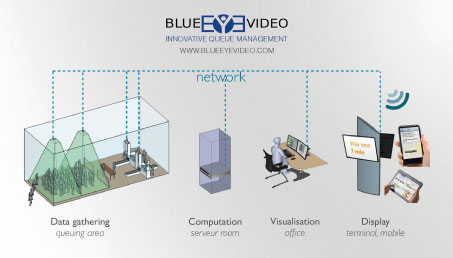
Innovative queue management expert Blue Eye Video utilises existing CCTV systems, or implements dedicated video cameras in airports, using its ingenious technology measures and predicts waiting times at security checkpoints, check-in areas, passport control, taxi lanes and any crowded airport environment.
The power of cutting-edge video analytics can revolutionise queue management in airports, and to reduce waiting times for a better passenger experience. Innovative queue management expert Blue Eye Video utilises existing CCTV systems, or implements dedicated video cameras in airports, and using its ingenious technology measures and predicts waiting times at security checkpoints, check-in areas, passport control, taxi lanes and any crowded airport environment. Blue Eye Video’s boundary-breaking technology instantly counts the number of passengers in an image, and then calculates waiting times and predicts the amount of time passengers will lose in queue.
“We give the passenger dynamic information to manage his time,” said Pierre-Jean Riviere, Founder & CEO, Blue Eye Video. “Our solution gives real-time data as a wayfinding solution meaning all passengers know how long they will wait in each queue. They can choose walking longer to wait less, as the solution identifies every point of entry, meaning some ‘hidden’ checkpoints may be revealed to passengers. The passenger knows if, for example, he has time to have a coffee with his friends before going to the security checkpoint. At passport control, he can be made aware if he will have a long wait and can be reassured about the time he needs to do make his connection between flights.”
Waiting times are displayed on a screen so that passengers are able to make an active decision about which queue to join, and when to join it. In this way the passenger load is balanced between all checkpoints, meaning that airports can allocate resources in real-time to avoid long queues, and are alerted when they need to reduce or increase the number of gates in relation to real-time measurement, forecast and planning.
In 2012 Blue Eye Video deployed its technology at all security checkpoints in Washington Dulles International Airport, and also equips immigration and security areas in two terminals at Paris Charles de Gaulle Airport.
LED signage leading the way
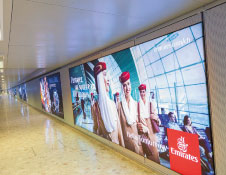
EPSiLON Aero’s ‘Banner PTS’ LED backlight advertising board with high brightness at low energy cost and low maintenance.
EPSiLON Aero – specialist in airport way finding systems and advertising boards – provides bespoke product development and high quality production all under one roof.
Evolved as a joint venture between EPSiLON NV Visible Solutions, Belgium, and Noventis viscom AG, Switzerland, EPSiLON Aero has a strong background, with experience in product development and production on the one hand, and in the airport business sector on the other, as well as nearly 22 years of experience in the design, production and installation of a wide range of illuminated and non-illuminated signs and displays, and street furniture in a variety of markets such as government, public transport, airports, petro-chemistry, banking and insurance companies, dealer networks, and clients in both B2B and B2C sectors.
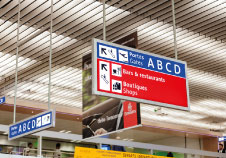
‘Show the Way Magneto’ wayfinding edge-LED light panel by EPSiLON Aero, with high light output at low energy consumption.
EPSiLON Aero’s core business is based on the most recent LED technologies for both edge and backlight applications, which result in products with high light output and low energy consumption. This technology is combined with attractive design systems, adjusted to customers’ specific project requirements. The installation of it signage elements is easy, and maintenance costs of the signs during their life cycle are negligible, and furthermore, the wayfinding products are slim and customisable, and as a result fit everywhere. Due to their extremely bright light output, the signs offer wayfinding support to streamline passenger process.
EPSiLON Aero has worked with airports including Geneva Airport, Copenhagen Airport, Budapest Airport, Eindhoven Airport and International Airport Donetsk Sergey Prokofiev, and is also globally present in travel retail.
In 2012 it equipped Geneva Airport with its wayfinding system, ‘Show the Way Magneto’, and its backlight advertising boards ‘Banner PTS’. About 600 Magneto wayfinding systems enhance the passenger experience in an airport with limited space and a very fast growing passenger flow, while the Banner PTS advertising concept not only functions as an advertising sign but also as illumination for public areas – the perfect balance between these two products resulting in EPSiLON Aero’s contribution to AIG’s success.
Considerable investment in its 15,000sqm production facility enables EPSiLON Aero to export its products and technologies on not only a European, but also a global level. Sustainability has always been highly valued, something translated not only in its products but also in its production facilities, through intelligent energy, water, and recycling management.
Planning for tomorrow today
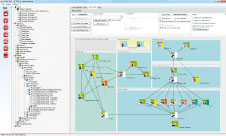
PAX2SIM provides airport capacity forecasts using airport database and process flow management. HUB Performance is launching the new 2013 version of PAX2SIM in July. It features an innovative new user interface for dynamic Gantt chart, user process and new process flow management.
Intelligent Information Technology is enabling airports to accurately predict their future resource needs. HUB Performance is an industry leader in the field, with its smart planning software for traffic forecasting.
“Our technology is used by airport staff to forecast, measure, compare and improve terminal operations from defined planning,” explained Jacques Natchia, Managing Director Airport Planning, HUB Performance. “It makes it possible to visualise ideas and make objective decisions, rather than speculating.”
Its PAX2SIM facility is an advanced simulation software that calculates and forecasts traffic using Airport database and process flow management, in a way unmatchable by a static calculator. “HUB Performance’s job has been to search for the ideal balance between ease of use, accuracy of forecasts and the price of the software, so it brought to the Airport Planning Business the concept of Terminal Smart Planning,” Natchia said.
The PAX2SIM solution – which is used weekly by Aeroporti Di Roma’s Operational Planning Team and in airports and businesses across Europe – performs long, middle and short-term planning, from sizing new projects and specifying needed space based on standards and capacity constraints, to enhancing existing operations by forecasting resource needs in relation to passenger dwell time targets and process flow optimisation.
The ingenious software enables airports to plan at times when maintaining an exceptional passenger experience is especially crucial. “By using PAX2SIM it remains possible to anticipate operation bottlenecks and long waiting times of a specific planning or temporary event such Olympic Games,” Natchia said. “It helps minimising waiting times at check points so the passenger experience can be improved. It also optimises material handling equipment systems in order to deliver bags in the best way.”
Proactively managing passenger flow
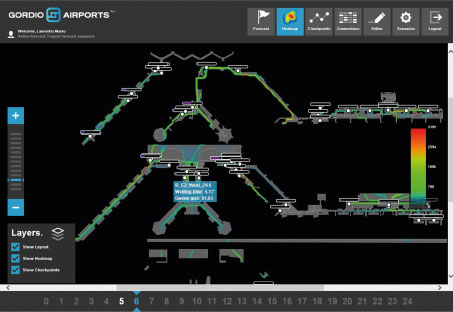
As well as enhancing Frankfurt Airport’s peak terminal capacity from 150,000 to 200,000 passengers a day, acp-IT’s state-of-the-art GORDIO AIRPORTS™ system can significantly reduce the airport’s operational and investment costs.
acp-IT has been a backbone of support to Frankfurt Airport since 2011 when it began providing its innovative solution for real-time passenger flow forecast and resource planning to Europe’s third largest hub.
As well as enhancing its peak terminal capacity from 150,000 to 200,000 passengers a day, allowing the airport to vastly postpone significant planned investments in infrastructure, state-of-the-art GORDIO AIRPORTS™ system can significantly reduce the airport’s operational and investment costs. According to studies, the introduction of proactive passenger flow management technology can achieve a 20% reduction in process costs at checkpoints.
Fully integrated with the Airport BI System, GORDIO AIRPORTS™ provides Frankfurt’s Terminal Operations Centre with continuously updated information concerning threats to passenger flow – before they actually happen – giving it the means to manage and control passenger flow in a proactive manner. The Operations team can therefore accurately plan the required resources and balance available ones, avoiding under or over-capacity situations. Proactive passenger flow management at Frankfurt Airport has led to an average reduction of 20% in waiting times for passengers at process points in the last two years.
“Passengers have important benefits from Terminal Operations Management relying on GORDIO AIRPORTS™, especially reduced and predictable wait times at check points. This is clearly shown by the fact that during the last two years, customer satisfaction increased significantly by more than 10%, an important part of which is thanks to reduced waiting times,” said Laurentiu Maniu, Business Unit Manager – GORDIO AIRPORTS™. “The staff also has advantages in the seasonal resource planning phase. Our very fast and fully-integrated solution helped the Planning team to reduce the complete planning process from 5 days to a few hours.”
acp-IT is now working with other airports to start new projects in Europe, the Middle East and Asia, and continues to improving it solution. “Recently we released a new version which includes an Optimisation feature, giving Operations Management a one-click solution to make best decision in the case of foreseen problems with long queues and waiting times,” Maniu commented. “We are working on and soon releasing the GORDIO AIRPORTS™ for Airside, which will bring airports the same proven solution, but this time to accurately forecast and analyse the flight landing trajectory and landing time, ground movements and departure procedure,” he concluded.







